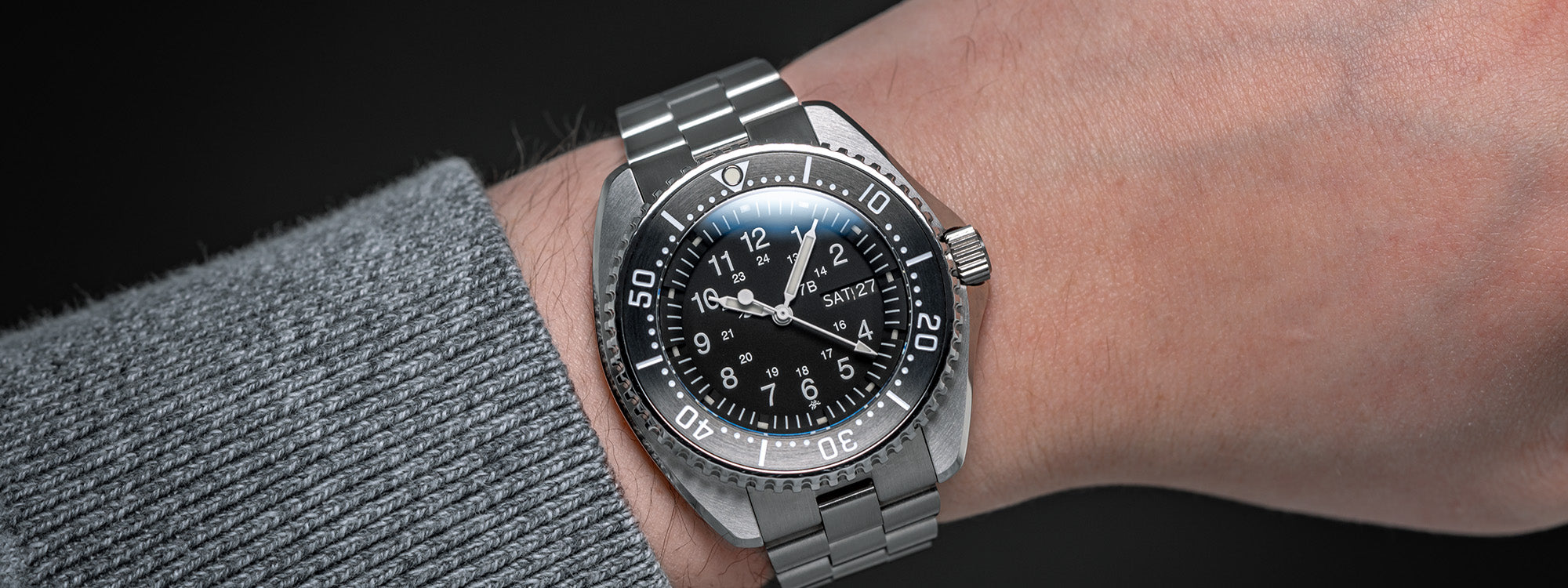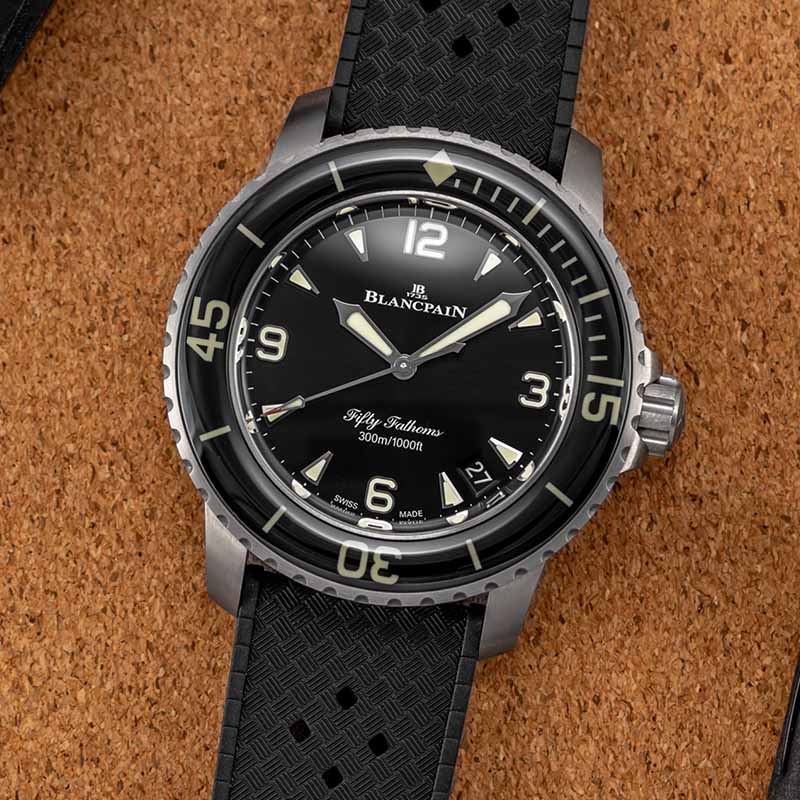The story of Tornek-Rayville is one that represents a significant chapter in both watchmaking and military history, from the earliest purpose-built watches for divers in the 1950s up to the re-emergence of the cult-classic brand (in a notably new form) in the 21st Century. And it begins with the development of the world’s first modern dive watch: the Blancpain Fifty Fathoms.
[toc-section heading="Blancpain Fifty Fathoms History"]
Founded in 1735 in Villeret, Switzerland, Blancpain is the oldest luxury watchmaker in the world, but its most famous timepiece in this modern era began its life as a tool watch for military divers in the (relatively) recent year of 1953. Jean-Jacques Fiechter, who headed Blancpain at the time, was an avid diving enthusiast who had long wanted to develop a watch that would be ideal for his hobby. Fiechter worked with Captain Robert Maloubier, a French naval officer, to design a reliable, mission-ready timepiece that Maloubier’s elite combat diving team could wear. The watch’s 42mm steel case — exceptionally large for the time — was water-resistant to 91.45 meters, or 50 fathoms, the maximum depth recommended for scuba divers. Its dial was black and its numerals were luminescent for greater legibility underwater.

It was the first divers’ watch with a self-winding movement, the first with an antimagnetic case, and the first to employ the patented, double-sealed crown that Fiechter had developed. Most notably, the Fifty Fathoms was the first watch to include a lockable bezel with dive-time scale that rotated in only one direction. This practical and potentially life-saving innovation prevented a diver from accidentally jarring the bezel in the wrong direction for an inaccurate reading of how much time he’d spent underwater and thus miscalculating how much oxygen he had left in the tank. (Read the full story behind the Fifty Fathoms here.) At first, the watch was issued exclusively to Maloubier’s team of French Navy divers, but other elite military units around the world also began to adopt it as well, and the United States Navy inevitably took notice of the Fifty Fathoms as well, around 1960.
[toc-section heading="Fifty Fathoms Becomes Tornek-Rayville"]

Photo: Sotheby's
The Fifty Fathoms’ path to official adoption by the United States military units, a distinction that has lent it a great deal of historical cachet, was not an easy one. With the war in Vietnam ramping up, the Navy started a search for a rugged, reliable watch that could be worn by the divers of its Underwater Demolition Team (UDT, a precursor of today’s Navy SEALs) and Blancpain’s widely lauded dive watch was already on the brass’s radar. In a government-sponsored watch competition — somewhat similar to the one that NASA would conduct years later to select a timepiece for space missions — Blancpain’s watch underwent a battery of tests, vying against other early dive watches like the Rolex Submariner and Enicar Sea Pearl 600. The tests included dropping a solid steel ball directly onto the watch’s crystal from 40 inches, subjecting the watches to extreme temperature changes, and even having divers wear them during the underwater atomic testing of the U.S.'s Operation Hardtack.

As the sole survivor of this tortuous regimen, and also owing to the fact that it was the only one of the trio of watches that had a dull, matte surface rather than a shiny, polished one (all the better for stealth diving), the Fifty Fathoms emerged as the victor, unanimously chosen as the watch of the U.S. Navy Underwater Demolition Team (or UDT, a precursor to the SEALs) — at least until another watch, previously commissioned from New York-based Bulova Watch Company was finished and cleared for use. But because of a law designed to protect American manufacturers from foreign competitors, getting it to its intended wearers would be tricky.
In 1933, U.S. President Herbert Hoover had signed the “Buy American Act,” which mandated that any goods eligible for federal contracts and procurements, i.e., equipment for military use, had to be sourced domestically, with a certain percentage of the components, and the final manufacturing, originating in the U.S.A. — with exceptions made only if a domestic option were unavailable or prohibitively expensive. This meant that a Swiss-made watch like the Blancpain Fifty Fathoms would not qualify for a military contract. It also might also explain why the Navy first reached out to Bulova — at the time, headed by a legitimate veteran war hero, General Omar Bradley — to produce such a watch; however, Bulova’s prototype, which inspired the modern, vintage-inspired MIL-SHIPS model, never made it to the mass-production stage and thus was never actually supplied to the Navy. (It’s apparent now, as it maybe was not so much then, that Bulova’s main focus at that time was on developing the Accutron, the world’s first electronic watch, and that the proposed military divers’ watch was simply back-burnered a bit too long.)

Photo: Phillips
Fortunately, a novel solution to the Navy’s dilemma was in the wings, courtesy of Allen V. Tornek, a New York-based distributor for Blancpain watches and other imported goods. Tornek, eager to claim the lucrative U.S. government contract, hit upon the idea of re-branding the Blancpain watches under a new name: Tornek-Rayville — “Tornek” from the distributor’s own name, “Rayville” being a vocal anagram of Blancpain’s Swiss hometown of Villeret, or "Ville-Ray.” “Rayville,” in fact, already existed as an alternate name for Blancpain on the corporate side. Due to an odd and since-repealed Swiss law, family-owned companies headquartered there were forced to change their name when control of them passed from the founding family, as had been the case with Blancpain back in 1933. The company had officially been known as Rayville SA ever since, even though “Blancpain” was still the name on the dials. For the watches intended for the U.S. Navy, however, Tornek not only needed to replace this venerable logo with “Tornek-Rayville” but also to make some small but substantial modifications to fudge the watches’ “Made in America’ claim. One of these involved exploiting small loopholes in the “Made in America’ law’s language, like the requirement that the watch’s jewels be purchased from a U.S. manufacturer. The law specified only purchase, not use, so Tornek was able to discard these jewels after procuring them and using the watch’s original Swiss-made jewels instead.
[toc-section heading="Tornek-Rayville at War"]
The Navy also requested some type of moisture indicator on the dial, and Blancpain complied by adding one at 6 o’clock, a disk that would change color whenever any moisture had penetrated into the case. Another specification, which made it into the second MIL-SPEC version of the watch, was the use of antimagnetic alloys in the case that would prevent a diver wearing the watch from triggering magnetic mines. It’s unclear how many Tornek-Rayville watches that Blancpain produced for U.S. military orders, though it may be as few as 1,000 pieces, delivered from 1964 through 1966. Worn by Navy UDT divers and Marine Force Recon teams, these original Tornek-Rayville watches are extremely rare and valuable today, as a great many of them were destroyed after their original users returned them to the Navy. The reason for this was the watches’ use of Promethium-147, a uranium-based radioactive element, for the luminous elements of the dials in those days before the potential dangers of such substances were fully known. The most famous and most collectible of the MIL-SPEC, Blancpain-produced Tornek-Rayville watches was the TR-900, built to all the military specs at the time including the disk-shaped moisture indicator. It is believed that only about 20 to 30 of these watches still exist today.

The U.S. Navy started looking at less expensive options — including some now-famous Seiko watches — for outfitting its divers as the Vietnam War expanded and demand grew around 1968. The Tornek-Rayville “brand” ceased to exist just a few years after it was established, and Blancpain itself went into a sort of hibernation shortly thereafter with the onset of the watch industry’s Quartz Crisis period. The Fifty Fathoms, despite its historical impact, seemed consigned to history until its recent major comeback in the 21st Century, starting with a handful of limited editions in 1997. Today, the Fifty Fathoms is a key pillar of Blancpain’s lineup, and arguably now the flagship of the entire brand, quite an accomplishment for a once-humble, military-use tool watch. The “Tornek-Rayville” era has remained a curious historical footnote in Blancpain’s centuries-spanning history — at least until very recently.
[toc-section heading="Today's Tornek-Rayville"]
The “Tornek Rayville” branding, which Blancpain abandoned back in the 1960s, has made a comeback in the dive-watch world — specifically, in the intriguing and increasingly relevant arena of small independent watchmaking. Entrepreneur Bill Yao, who had previously founded the tool-watch brand MKII, relaunched acquired the brand name and launched the new Tornek-Rayville in 2010, with a heavy emphasis on a reissued version of the most legendary model, the aforementioned TR-900, which was worn by U.S. special forces during the Vietnam War. That watch was dubbed the TR-660, and its stunning success ushered in a series of similarly vintage-military-influenced watches from the modern Tornek-Rayville. Here is a look at the models currently available, all of which are manufactured in Japan.
Tornek-Rayville TR-660

The flagship TR-660 model is a dose of Fifty Fathoms DNA at a far more accessible price point than you’re going to see from Blancpain these days. The watch has a 40mm case in bead-blasted stainless steel (14.7mm thick), with a screw-down crown and a unidirectional dive-scale bezel. The 200-meter water resistance is respectable, and more than double that of the 1960s model that inspired it. The sapphire crystal over the dial is double-domed and antireflective, and the screw-down crown has a double-gasket design for extra security. The movement inside is not Swiss-made but Japanese: the automatic TMI NH38 from Seiko, which includes the hacking seconds function that military users would have found essential, as well as a 41-hour power reserve. The TR-660, the first version of which sold out quickly, was available on a variety of straps, including rubber and a woven nylon NATO, and it used modern, non-radioactive Super-LumiNova (rather than the period-appropriate but decidedly hazardous promethium) for its luminous hands and markers.
Tornek-Rayville TR Type 7B “Blakjak”

The Type 7B “Blakjak,” the microbrand’s military-style pilot’s watch, is a modern reissue of the MIL-W-46374F Type 6 SANDY 660 design, best known for its use on watches produced by Stocker & Yale, a now-defunct U.S.-based producer of watches for military units. This watch — which somewhat resembles the Navigator models from Canada’s Marathon Watch Company, another military watch purveyor — takes its cues from the Stocker & Yale timepieces widely worn by U.S. service members during the wars in Iraq and Afghanistan. Its 42.5mm steel case is 13.2mm thick and a rather expansive 49mm lug to lug, with a flat sapphire crystal over a black dial with both a 12-hour and 24-hour ring, in the style of classical field watches. The movement inside the 200-meter water resistant case is Seiko’s SII NH36, with a quick-set date, hacking seconds, and a 41-hour power reserve. Tornek-Rayville has customized this automatic caliber with a day and date wheels, their practical indication displayed in a dual window at 3 o’clock.
Tornek-Rayville Paradive C3 Type 1

Tornek-Rayville’s Paradive models take inspiration from dive watches provided to servicemen in the 1970s that were built to the MIL-W-50717 specs demanded by the U.S. military at the time. Makers of these watches included familiar names like Timex, Hamilton, Westclox, and Benrus, whose Type I and Type II models, supplied to service members during the Vietnam era, are the most famous today among collectors. Tornek-Rayville revisits this utilitarian style, with its 41.25mm stainless steel case (15.54mm thick) and a matte black dial, with geometrical hour markers and pencil-shaped hands all coated in Arclite Super-LumiNova. The case has a three-part construction, with a 12-hour scale on an aluminum insert inside the ratcheting bezel. Another Japanese movement, the SII NE15 with a côtes-de-Genève-adorned rotor, powers the watch behind its solid caseback.
CISO M38 - Field

The smallest option among the contemporary Tornek-Rayville offerings is the CISO M38 Field model, measuring a relatively modest 38mm in stainless steel (12.45mm thick and 43.6mm lug to lug), which is widely regarded as ideal dimensions for a military field watch (i.e., one intended for use on land rather than underwater). CISO stands for “Counter Insurgency Support Office,” which is the U.S. government agency that commissioned the original watch from which this piece takes inspiration, the Seiko 6119. Initially a limited edition of 500 pieces, the “Series 1” of the watch comes on a stainless steel end-link bracelet and features an eye-catching two-tone day-date display at 3 o’clock. The back of the case is engraved with the motto of Vietnam-era Special Operations Groups (SOGs): “You haven’t lived until you’ve almost died.”



















































0 Comments